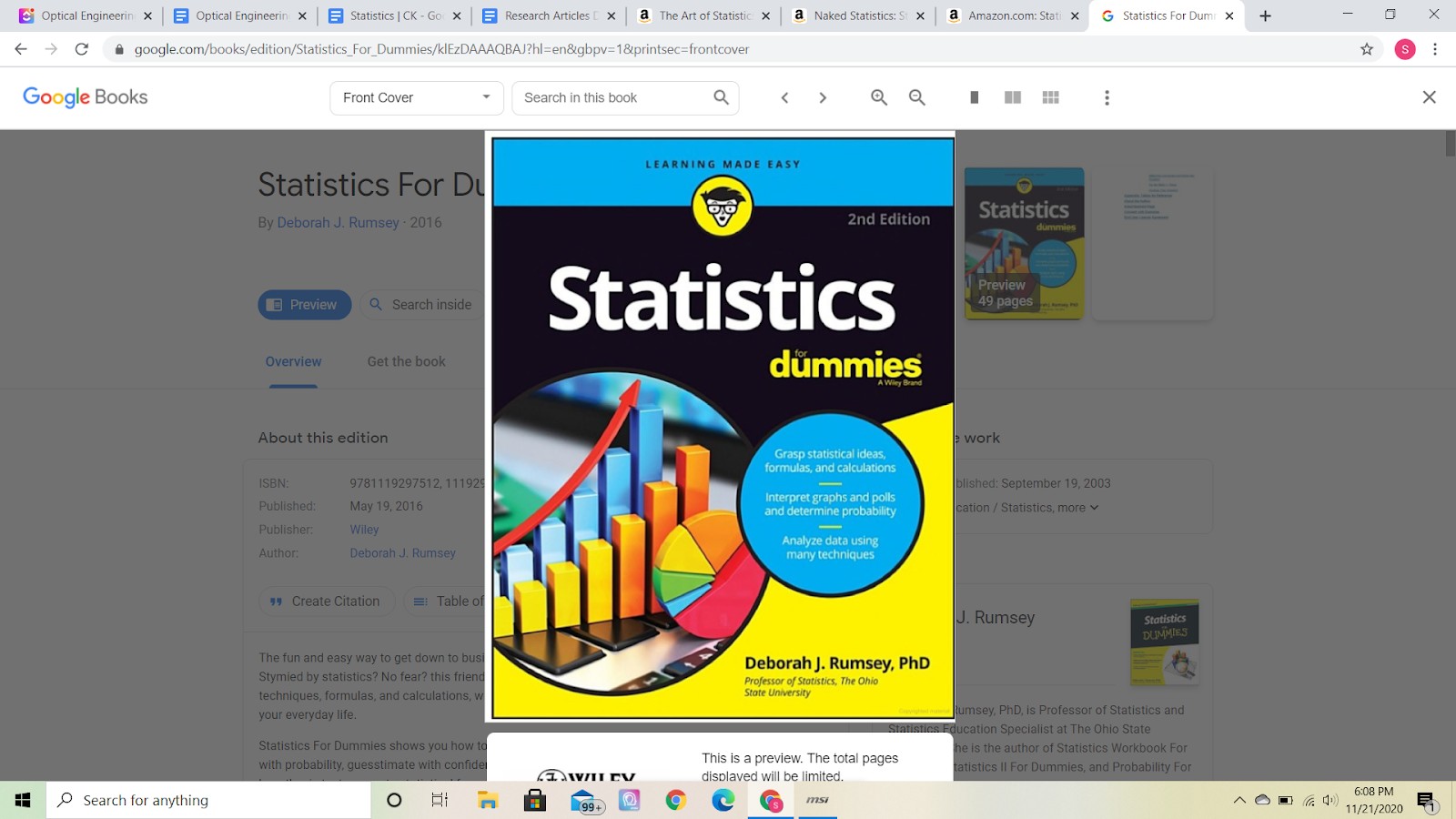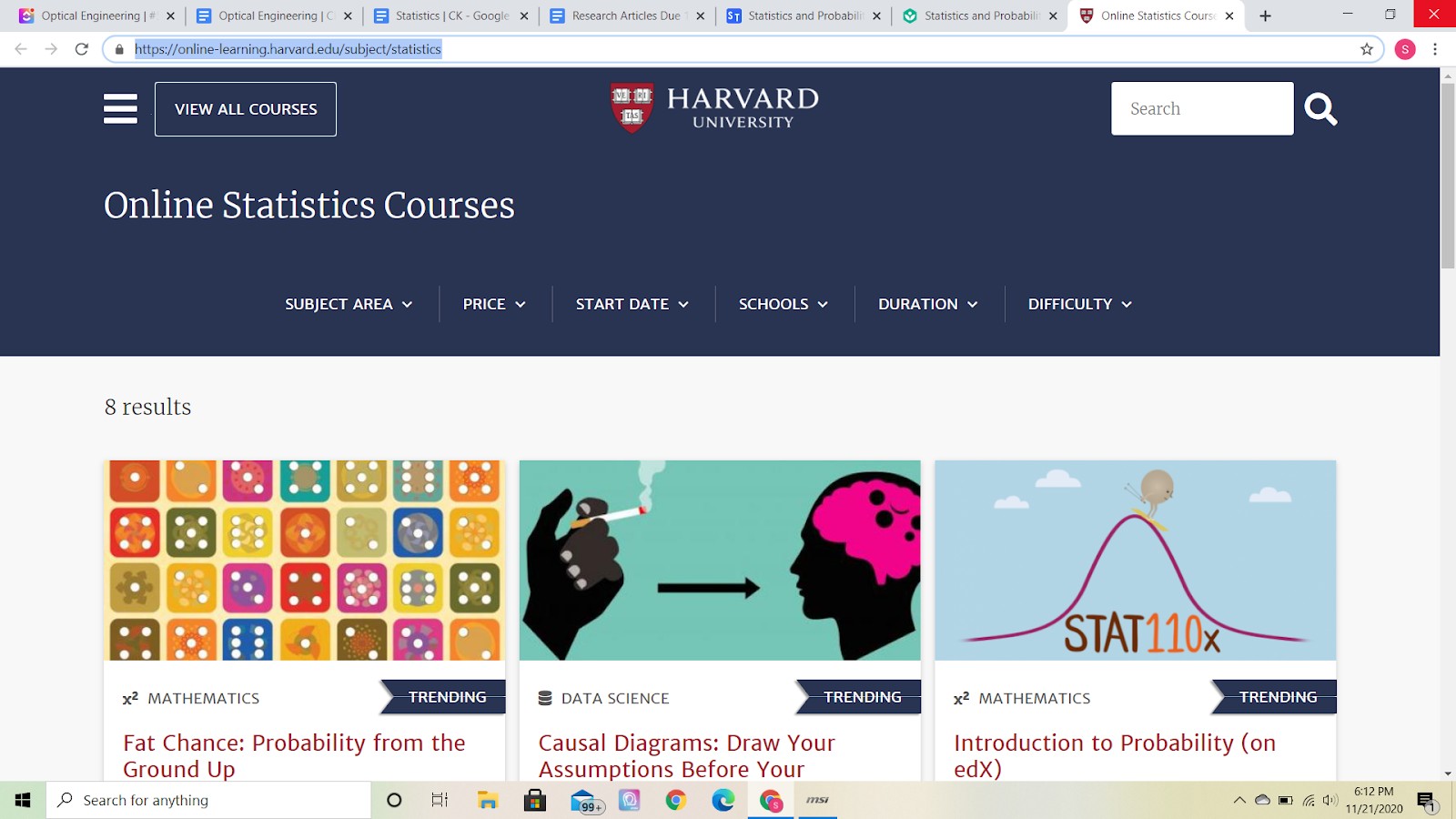Are you curious about How Long Does It Take To Learn Statistics? This comprehensive guide from LEARNS.EDU.VN breaks down the learning process, offering a realistic timeline and practical steps to master this essential skill. Whether you’re interested in statistical analysis, data interpretation, or simply want to understand the numbers behind the news, we provide the roadmap to statistical proficiency. Explore probability theory, statistical inference, and data visualization techniques to unlock the power of data!
1. Understanding Statistics: A Gateway to Data Mastery
Statistics is more than just numbers; it’s the art and science of extracting meaningful insights from data. It involves collecting, analyzing, interpreting, and presenting data to uncover patterns, trends, and relationships. By mastering statistics, you gain a powerful toolkit for making informed decisions in various fields.
1.1. The Breadth of Statistical Applications
Statistics isn’t confined to textbooks and classrooms. It’s a vital tool in diverse sectors:
- Healthcare: Analyzing clinical trial data to determine the effectiveness of new treatments.
- Finance: Predicting market trends and managing investment risks.
- Marketing: Understanding consumer behavior and optimizing advertising campaigns.
- Social Sciences: Studying societal trends and evaluating the impact of policies.
- Engineering: Improving product quality and reliability through statistical process control.
- Education: Evaluating teaching methods and student performance.
1.2. Descriptive vs. Inferential Statistics: Two Sides of the Same Coin
Statistics can be broadly categorized into two main branches: descriptive and inferential.
- Descriptive Statistics: Focuses on summarizing and presenting data in a meaningful way. This includes measures of central tendency (mean, median, mode), measures of dispersion (standard deviation, variance), and graphical representations (histograms, pie charts).
- Inferential Statistics: Involves drawing conclusions and making generalizations about a population based on a sample of data. This includes hypothesis testing, confidence intervals, and regression analysis.
2. Decoding the Timeline: How Long to Learn Statistics?
The question of how long does it take to learn statistics doesn’t have a single answer. The timeline depends on your learning goals, prior knowledge, and chosen learning path.
2.1. Factors Influencing Learning Time
Several factors affect the time it takes to acquire statistical skills:
- Learning Goals: Do you need a basic understanding for personal use, or are you aiming for a career in data analysis?
- Prior Knowledge: A strong foundation in mathematics, especially algebra and calculus, can accelerate the learning process.
- Learning Method: Self-study, online courses, or formal education programs each offer different learning speeds and structures.
- Time Commitment: Dedicating more hours per week to studying will naturally lead to faster progress.
- Learning Style: Identifying your preferred learning style (visual, auditory, kinesthetic) can help you choose the most effective resources and techniques.
2.2. Estimated Timelines for Different Learning Paths
Here’s a breakdown of estimated timelines for various approaches to learning statistics:
- Basic Understanding for Personal Use:
- Focus: Descriptive statistics, data interpretation.
- Time: 1-3 months, studying a few hours per week.
- Resources: Online tutorials, introductory textbooks.
- Introductory College Course:
- Focus: Descriptive and inferential statistics, basic probability.
- Time: One semester (15-16 weeks), with associated coursework.
- Resources: Textbook, lectures, assignments.
- Data Analysis Skills for a Specific Job:
- Focus: Relevant statistical techniques for the industry (e.g., A/B testing for marketing, regression analysis for finance).
- Time: 3-6 months, with dedicated study and practice.
- Resources: Online courses, specialized workshops, real-world projects.
- Statistics Degree (Bachelor’s or Master’s):
- Focus: Comprehensive understanding of statistical theory and methods.
- Time: 2-4 years for a Bachelor’s, 1-2 years for a Master’s.
- Resources: University courses, research projects, internships.
Table 1: Estimated Timelines for Learning Statistics
| Learning Goal | Estimated Time | Time Commitment per Week | Resources |
|---|---|---|---|
| Basic Understanding | 1-3 months | 2-5 hours | Online tutorials, introductory textbooks |
| Introductory College Course | 1 semester | 5-10 hours | Textbook, lectures, assignments |
| Data Analysis Skills for a Specific Job | 3-6 months | 10-20 hours | Online courses, specialized workshops, real-world projects |
| Statistics Degree (Bachelor’s or Master’s) | 2-4 years (B), 1-2 (M) | Full-time study | University courses, research projects, internships |



3. A Step-by-Step Guide to Mastering Statistics
Ready to embark on your statistical journey? Here’s a structured approach to help you learn statistics effectively:
3.1. Laying the Foundation: Essential Prerequisites
- Basic Math Skills: Ensure you have a solid understanding of algebra, including equations, functions, and graphing. Familiarity with calculus is beneficial for advanced topics.
- Familiarity with Spreadsheets: Learn to use spreadsheet software like Microsoft Excel or Google Sheets. These tools are essential for data manipulation and analysis.
3.2. Building Blocks: Descriptive Statistics
- Data Collection and Organization: Learn how to gather data from various sources and organize it into tables and databases.
- Measures of Central Tendency: Master the calculation and interpretation of mean, median, and mode.
- Measures of Dispersion: Understand standard deviation, variance, range, and interquartile range to assess data variability.
- Data Visualization: Create histograms, scatter plots, box plots, and other graphs to visualize data patterns.
3.3. Stepping Up: Inferential Statistics
- Probability Theory: Learn the fundamentals of probability, including probability distributions (normal, binomial, Poisson).
- Sampling Methods: Understand different sampling techniques and their impact on statistical inference.
- Hypothesis Testing: Formulate and test hypotheses using statistical tests like t-tests, chi-square tests, and ANOVA.
- Confidence Intervals: Construct confidence intervals to estimate population parameters.
- Regression Analysis: Explore the relationship between variables using linear and multiple regression models.
3.4. Advanced Techniques: Predictive Modeling and Beyond
- Predictive Modeling: Learn about advanced modeling techniques like logistic regression, time series analysis, and machine learning algorithms.
- Experimental Design: Understand principles of experimental design to conduct valid and reliable studies.
- Statistical Software: Gain proficiency in statistical software packages like R, Python (with libraries like NumPy, Pandas, and Scikit-learn), or SAS.
4. Resources for Statistical Education
The path to statistical literacy is paved with diverse resources. Here’s a curated selection to suit different learning preferences:
4.1. Formal Education: University Courses and Programs
- Undergraduate Degrees: A Bachelor’s degree in Statistics, Mathematics, or a related field provides a strong foundation in statistical theory and methods.
- Graduate Degrees: A Master’s or Doctoral degree in Statistics offers advanced training for research and specialized applications.
- Community Colleges: Many community colleges offer introductory statistics courses as part of their general education curriculum.
4.2. Online Courses: Flexible Learning at Your Fingertips
- Coursera: Offers a wide range of statistics courses from top universities and institutions, including specializations in data science and machine learning.
- edX: Provides access to university-level statistics courses, often with the option to earn a verified certificate.
- Udemy: Features practical statistics courses for various applications, such as business analysis and data science.
- Khan Academy: Offers free, comprehensive statistics tutorials covering basic concepts to advanced topics.
4.3. Books: A Wealth of Knowledge in Print
- Statistics for Dummies by Deborah J. Rumsey: A user-friendly guide for beginners, covering essential concepts in a clear and accessible manner.
- Naked Statistics: Stripping the Dread from the Data by Charles Wheelan: An engaging and entertaining book that makes statistics less intimidating.
- The Art of Statistics: How to Learn from Data by David Spiegelhalter: A realistic and insightful approach to understanding statistics in the real world.
4.4. Statistical Software: Tools for Data Analysis
- R: A free, open-source programming language and environment for statistical computing and graphics.
- Python: A versatile programming language with powerful libraries for data analysis, such as NumPy, Pandas, and Scikit-learn.
- SAS: A comprehensive statistical software suite widely used in business, healthcare, and research.
- SPSS: A user-friendly statistical software package popular in social sciences and market research.
Table 2: Top Resources for Learning Statistics
| Resource Type | Examples | Description |
|---|---|---|
| Formal Education | University courses, community colleges | Provides a structured curriculum, expert instruction, and opportunities for hands-on practice. |
| Online Courses | Coursera, edX, Udemy, Khan Academy | Offers flexible learning options with a wide range of courses to suit different skill levels and interests. |
| Books | Statistics for Dummies, Naked Statistics, The Art of Statistics | Provides in-depth explanations of statistical concepts and techniques, often with real-world examples and exercises. |
| Statistical Software | R, Python, SAS, SPSS | Enables you to perform data analysis, create visualizations, and build statistical models. |
| Online Resources | Statistical blogs, forums, tutorials (e.g., Stat Trek, Harvard Online Learning) | Provides free access to information, tutorials, and discussions on statistical topics. |
5. The Value of Statistical Certifications
Earning a statistics certification can significantly enhance your career prospects and demonstrate your expertise to potential employers.
5.1. Types of Statistics Certifications
- Professional Certifications: Offered by organizations like the American Statistical Association (ASA) or the Royal Statistical Society (RSS), these certifications validate your knowledge and skills in specific areas of statistics.
- Vendor-Specific Certifications: Offered by software vendors like SAS or IBM, these certifications demonstrate your proficiency in using their statistical software.
- Academic Certifications: Offered by universities or colleges, these certifications provide focused training in specific statistical techniques or applications.
5.2. Benefits of Certification
- Career Advancement: Certifications can increase your earning potential and open doors to new job opportunities.
- Credibility and Recognition: Certifications validate your skills and knowledge, making you a more attractive candidate to employers.
- Professional Development: Preparing for a certification exam can help you deepen your understanding of statistical concepts and techniques.
5.3. Popular Certification Programs
- Statistics.com Certificates: Offers nine different statistics-related certificate options, covering areas like analytics for data science and biostatistics.
- Applied Statistics Certificate (Texas A&M University): A versatile program that allows you to specialize in a specific area of statistics or gain a broad education across different disciplines.
6. Online Statistics Resources
The internet is a treasure trove of statistical knowledge. Here are some of the best online resources to enhance your learning:
6.1. Free Educational Platforms
- Harvard Online Learning: Offers a variety of free statistics courses, providing a learning experience comparable to on-campus studies.
- Khan Academy: Provides detailed tutorials and courses covering a wide range of statistical topics, from basic concepts to advanced techniques.
- Stat Trek: Offers free online tutorials for both basic and complex statistical concepts, allowing you to learn at your own pace.
6.2. Online Communities and Forums
- Cross Validated (Stack Exchange): A question-and-answer site for statistics and data analysis, where you can ask questions, share knowledge, and learn from experts.
- Reddit (r/statistics, r/datascience): Online communities where you can discuss statistical topics, share resources, and connect with other learners.
7. Is Studying Statistics Worth It?
Absolutely! In today’s data-driven world, statistical skills are highly valued across various industries.
7.1. Career Opportunities
A strong foundation in statistics can lead to exciting career paths:
- Data Scientist: Extracts insights from large datasets to solve business problems.
- Statistician: Develops and applies statistical methods to collect, analyze, and interpret data.
- Data Analyst: Cleans, analyzes, and visualizes data to identify trends and patterns.
- Market Research Analyst: Studies consumer behavior and market trends using statistical methods.
- Financial Analyst: Uses statistical models to assess investment risks and opportunities.
- Actuary: Assesses and manages financial risks using statistical and mathematical models.
7.2. Real-World Applications
Statistics isn’t just for professionals. It’s a valuable tool for making informed decisions in your personal life:
- Evaluating Health Information: Understanding statistical claims in medical studies and news reports.
- Making Financial Decisions: Assessing investment risks and understanding financial statistics.
- Understanding Social Issues: Interpreting data related to social trends and public policy.
8. LEARNS.EDU.VN: Your Partner in Statistical Learning
At LEARNS.EDU.VN, we are committed to providing you with the resources and support you need to succeed in your statistical journey.
8.1. Expert-Curated Content
Our website features articles, tutorials, and guides written by experienced statisticians and educators. We strive to explain complex concepts in a clear and accessible manner, making statistics easier to understand.
8.2. Personalized Learning Paths
We offer personalized learning paths tailored to your specific goals and interests. Whether you’re a beginner looking to learn the basics or an experienced professional seeking to enhance your skills, we have the resources to help you succeed.
8.3. Community Support
Join our online community to connect with other learners, ask questions, and share your knowledge. Our forum is a supportive and collaborative environment where you can learn from others and get the help you need.
9. FAQs: Your Questions Answered
Here are some frequently asked questions about learning statistics:
-
Is statistics hard to learn?
Statistics can be challenging, but with the right resources and a structured approach, it’s definitely achievable.
-
Do I need a strong math background to learn statistics?
A basic understanding of algebra is essential, and calculus is helpful for advanced topics.
-
What are the best online courses for learning statistics?
Coursera, edX, Udemy, and Khan Academy offer excellent statistics courses for all skill levels.
-
What software should I use for statistical analysis?
R, Python, SAS, and SPSS are popular choices, depending on your needs and preferences.
-
How can I apply statistics in my career?
Statistics is used in a wide range of industries, including healthcare, finance, marketing, and social sciences.
-
What are the benefits of earning a statistics certification?
Certifications can enhance your career prospects, increase your earning potential, and demonstrate your expertise.
-
How long does it take to become a data scientist with a statistics background?
It typically takes 1-2 years of dedicated study and practice to transition into a data science role.
-
What are the key skills needed for a career in statistics?
Strong analytical skills, problem-solving abilities, and proficiency in statistical software are essential.
-
How can I stay up-to-date with the latest statistical trends and techniques?
Follow statistical blogs, attend conferences, and participate in online communities to stay informed.
-
Where can I find reliable data sources for statistical analysis?
Government agencies, research institutions, and online data repositories offer a wealth of data for analysis.
10. Take the Next Step with LEARNS.EDU.VN
Ready to unlock the power of statistics and transform your career? Visit LEARNS.EDU.VN today to explore our comprehensive resources, personalized learning paths, and supportive community.
- Discover: In-depth articles and tutorials on statistical concepts and techniques.
- Learn: Engaging online courses designed to suit your learning style and goals.
- Connect: Join our community forum to network with other learners and experts.
Contact us:
- Address: 123 Education Way, Learnville, CA 90210, United States
- WhatsApp: +1 555-555-1212
- Website: LEARNS.EDU.VN
Let learns.edu.vn be your guide to mastering the art and science of statistics! Discover the insights and skills that can transform your career and empower you to make informed decisions in every aspect of your life. Start your journey today and unlock the power of data!